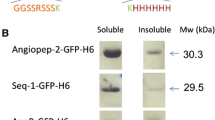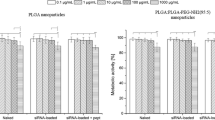Abstract
Purpose
To evaluate the effect of re-directing the uptake mechanism of polyplexes containing oligodeoxynucleotide (ODN) decoys to nuclear factor kappa B (NF-κB) from absorptive-mediated to receptor-mediated endocytosis.
Materials and Methods
Complexes of ODNs and a co-polymer of biotin–polyethylenglycol and polyethylenimine (BPP) were targeted to brain-derived endothelial cells with a conjugate of antibody 8D3 and streptavidin (8D3SA). Size and stability of ODN/BPP complexes was measured by dynamic light scattering. Cellular uptake was studied by confocal microscopy. Cell viability and pharmacological effects were investigated on murine bEnd5 cells stimulated with tumor necrosis factor.
Results
ODN/BPP complexes showed sizes of 116 ± 2.3 nm, which increased by 40 nm when coupled to 8D3SA, and were stable in physiological fluids. Targeted complexes were internalized intact into endosomal compartments. Treatment conditions, which yielded significant inhibitory effects on mRNA expression of VCAM-1, ICAM-1, IκBα and iNOS by bEnd5 cells, did not affect viability. At 0.5 μM, decoy ODN significantly inhibited monocyte adhesion to bEnd5 monolayers when delivered as 8D3SA-targeted complex, while higher concentrations of untargeted complex were ineffective.
Conclusions
The complex of NF-κB decoys and BPP, which can be targeted to transferrin receptors, is a promising drug candidate for neuroinflammatory diseases affecting the blood–brain barrier.








Similar content being viewed by others
Abbreviations
- BBB:
-
blood–brain barrier
- BCECF-AM:
-
2′,7′-bis-(carboxyethyl)-5-(6)-carboxyfluorescein-acetoxymethyl ester
- BPP:
-
biotin–polyethylenglycol–polyethylenimine
- ICAM-1:
-
intercellular adhesion molecule 1
- LMW-PEI:
-
low molecular weight polyethylenimine
- NF-κB:
-
nuclear factor kappaB
- ODN:
-
oligodeoxynucleotide
- PEG:
-
poly (ethylene glycol)
- PEI:
-
polyethylenimine
- SA:
-
streptavidin
- S-SMPB:
-
sulfosuccinimidyl 4-[p-maleimidophenyl]butyrate
- VCAM-1:
-
vascular cell adhesion molecule 1
- 8D3SA:
-
8D3-streptavidin
References
M. J. Mann. Transcription factor decoys: a new model for disease intervention. Ann. N. Y. Acad. Sci. 1058:128–139 (2005).
D. Fischer, R. Bhattacharya, B. Osburg, and U. Bickel. Inhibition of monocyte adhesion on brain-derived endothelial cells by NF-kappaB decoy/polyethylenimine complexes. J. Gene Med. 7:1063–1076 (2005).
L. Steinman. Blocking adhesion molecules as therapy for multiple sclerosis: natalizumab. Nat. Rev. Drug Discov. 4:510–518 (2005).
T. A. Yednock, C. Cannon, L. C. Fritz, F. Sanchez-Madrid, L. Steinman, and N. Karin. Prevention of experimental autoimmune encephalomyelitis by antibodies against alpha 4 beta 1 integrin. Nature 356:63–66 (1992).
D. H. Miller, O. A. Khan, W. A. Sheremata, L. D. Blumhardt, G. P. Rice, M. A. Libonati, A. J. Willmer-Hulme, C. M. Dalton, K. A. Miszkiel, and P. W. O’Connor. A controlled trial of natalizumab for relapsing multiple sclerosis. N. Engl. J. Med. 348:15–23 (2003).
D. Fischer, B. Osburg, H. Petersen, T. Kissel, and U. Bickel. Effect of poly(ethylene imine) molecular weight and pegylation on organ distribution and pharmacokinetics of polyplexes with oligodeoxynucleotides in mice. Drug Metab. Dispos. 32:983–992 (2004).
U. Bickel, T. Yoshikawa, and W. M. Pardridge. Delivery of peptides and proteins through the blood–brain barrier. Adv. Drug Deliv. Rev. 46:247–279 (2001).
W. M. Pardridge. Blood–brain barrier drug targeting: the future of brain drug development. Mol. Interv. 3:90–105, 151 (2003).
H. J. Lee, B. Engelhardt, J. Lesley, U. Bickel, and W. M. Pardridge. Targeting rat anti-mouse transferrin receptor monoclonal antibodies through blood–brain barrier in mouse. J. Pharmacol. Exp. Ther. 292:1048–1052 (2000).
H. J. Lee, Y. Zhang, C. Zhu, K. Duff, and W. M. Pardridge. Imaging brain amyloid of Alzheimer disease in vivo in transgenic mice with an Abeta peptide radiopharmaceutical. J. Cereb. Blood Flow Metab. 22:223–231 (2002).
N. Shi, Y. Zhang, C. Zhu, R. J. Boado, and W. M. Pardridge. Brain-specific expression of an exogenous gene after i.v. administration. Proc. Natl. Acad. Sci. U. S. A. 98:12754–12759 (2001).
Y. Zhang and W. M. Pardridge. Delivery of beta-galactosidase to mouse brain via the blood–brain barrier transferrin receptor. J. Pharmacol. Exp. Ther. 313:1075–1081 (2005).
H. J. Lee, R. J. Boado, D. A. Braasch, D. R. Corey, and W. M. Pardridge. Imaging gene expression in the brain in vivo in a transgenic mouse model of Huntington’s disease with an antisense radiopharmaceutical and drug-targeting technology. J. Nucl. Med. 43:948–956 (2002).
D. Fischer, T. Bieber, Y. Li, H. P. Elsasser, and T. Kissel. A novel non-viral vector for DNA delivery based on low molecular weight, branched polyethylenimine: effect of molecular weight on transfection efficiency and cytotoxicity. Pharm. Res. 16:1273–1279 (1999).
M. Laschinger and B. Engelhardt. Interaction of alpha4-integrin with VCAM-1 is involved in adhesion of encephalitogenic T cell blasts to brain endothelium but not in their transendothelial migration in vitro. J. Neuroimmunol. 102:32–43 (2000).
A. von Harpe, H. Petersen, Y. Li, and T. Kissel. Characterization of commercially available and synthesized polyethylenimines for gene delivery. J. Control. Release 69:309–322 (2000).
B. Osburg. Drug delivery of Oligonucleotides at the Blood–Brain Barrier: A Therapeutic Strategy for Inflammatory Diseases of the Central Nervous System, Physiology, Philipps-University, Marburg, 2003, pp. 1–121.
M. I. Cybulsky, M. Allan-Motamed, and T. Collins. Structure of the murine VCAM1 gene. Genomics 18:387–391 (1993).
R. K. Rohnelt, G. Hoch, Y. Reiss, and B. Engelhardt. Immunosurveillance modelled in vitro: naive and memory T cells spontaneously migrate across unstimulated microvascular endothelium. Int. Immunol. 9:435–450 (1997).
K. Kunath, A. von Harpe, D. Fischer, H. Petersen, U. Bickel, K. Voigt, and T. Kissel. Low-molecular-weight polyethylenimine as a non-viral vector for DNA delivery: comparison of physicochemical properties, transfection efficiency and in vivo distribution with high-molecular-weight polyethylenimine. J. Control. Release 89:113–125 (2003).
M. Ogris, P. Steinlein, M. Kursa, K. Mechtler, R. Kircheis, and E. Wagner. The size of DNA/transferrin-PEI complexes is an important factor for gene expression in cultured cells. Gene Ther. 5:1425–1433 (1998).
D. Goula, J. S. Remy, P. Erbacher, M. Wasowicz, G. Levi, B. Abdallah, and B. A. Demeneix. Size, diffusibility and transfection performance of linear PEI/DNA complexes in the mouse central nervous system. Gene Ther. 5:712–717 (1998).
L. Wightman, R. Kircheis, V. Rossler, S. Carotta, R. Ruzicka, M. Kursa, and E. Wagner. Different behavior of branched and linear polyethylenimine for gene delivery in vitro and in vivo. J. Gene Med. 3:362–372 (2001).
W. T. Godbey, K. K. Wu, and A. G. Mikos. Tracking the intracellular path of poly(ethylenimine)/DNA complexes for gene delivery. Proc. Natl. Acad. Sci. U. S. A. 96:5177–5181 (1999).
T. Merdan, K. Kunath, D. Fischer, J. Kopecek, and T. Kissel. Intracellular processing of poly(ethylene imine)/ribozyme complexes can be observed in living cells by using confocal laser scanning microscopy and inhibitor experiments. Pharm. Res. 19:140–146 (2002).
T. Merdan, J. Kopecek, and T. Kissel. Prospects for cationic polymers in gene and oligonucleotide therapy against cancer. Adv. Drug Deliv. Rev. 54:715–758 (2002).
R. Kircheis, L. Wightman, and E. Wagner. Design and gene delivery activity of modified polyethylenimines. Adv. Drug Deliv. Rev. 53:341–358 (2001).
O. Boussif, F. Lezoualc’h, M. A. Zanta, M. D. Mergny, D. Scherman, B. Demeneix, and J. P. Behr. A versatile vector for gene and oligonucleotide transfer into cells in culture and in vivo: polyethylenimine. Proc. Natl. Acad. Sci. U. S. A. 92:7297–7301 (1995).
M. Ogris, P. Steinlein, S. Carotta, S. Brunner, and E. Wagner. DNA/polyethylenimine transfection particles: influence of ligands, polymer size, and PEGylation on internalization and gene expression. AAPS PharmSci. 3:E21 (2001).
O. Germershaus, T. Merdan, U. Bakowsky, M. Behe, and T. Kissel. Trastuzumab-polyethylenimine-polyethylene glycol conjugates for targeting her2-expressing tumors. Bioconjug. Chem. 17:1190–1199 (2006).
A. Kichler. Gene transfer with modified polyethylenimines. J. Gene Med. 6(Suppl 1):S3–S10 (2004).
S. V. Vinogradov, T. K. Bronich, and A. V. Kabanov. Self-assembly of polyamine-poly(ethylene glycol) copolymers with phosphorothioate oligonucleotides. Bioconjug. Chem. 9:805–812 (1998).
S. Vinogradov, E. Batrakova, S. Li, and A. Kabanov. Polyion complex micelles with protein-modified corona for receptor-mediated delivery of oligonucleotides into cells. Bioconjug. Chem. 10:851–860 (1999).
R. M. Schiffelers, A. Ansari, J. Xu, Q. Zhou, Q. Tang, G. Storm, G. Molema, P. Y. Lu, P. V. Scaria, and M. C. Woodle. Cancer siRNA therapy by tumor selective delivery with ligand-targeted sterically stabilized nanoparticle. Nucleic Acids Res. 32:e149 (2004).
S. Mao, M. Neu, O. Germershaus, O. Merkel, J. Sitterberg, U. Bakowsky, and T. Kissel. Influence of polyethylene glycol chain length on the physicochemical and biological properties of poly(ethylene imine)-graft-poly(ethylene glycol) block copolymer/SiRNA polyplexes. Bioconjug. Chem. 17:1209–1218 (2006).
R. Morishita, T. Sugimoto, M. Aoki, I. Kida, N. Tomita, A. Moriguchi, K. Maeda, Y. Sawa, Y. Kaneda, J. Higaki, and T. Ogihara. In vivo transfection of cis element “decoy” against nuclear factor-kappaB binding site prevents myocardial infarction. Nat. Med. 3:894–899 (1997).
S. Fichtner-Feigl, I. J. Fuss, J. C. Preiss, W. Strober, and A. Kitani. Treatment of murine Th1- and Th2-mediated inflammatory bowel disease with NF-kappa B decoy oligonucleotides. J. Clin. Invest. 115:3057–3071 (2005).
C. Desmet, P. Gosset, B. Pajak, D. Cataldo, M. Bentires-Alj, P. Lekeux, and F. Bureau. Selective blockade of NF-kappa B activity in airway immune cells inhibits the effector phase of experimental asthma. J. Immunol. 173:5766–5775 (2004).
J. R. Perez, Y. Li, C. A. Stein, S. Majumder, A. van Oorschot, and R. Narayanan. Sequence-independent induction of Sp1 transcription factor activity by phosphorothioate oligodeoxynucleotides. Proc. Natl. Acad. Sci. U. S. A. 91:5957–5961 (1994).
R. M. Ransohoff. Natalizumab and PML. Nat. Neurosci. 8:1275 (2005).
Acknowledgments
The authors thank Dr. Holger Petersen (Basel) for synthesis and analysis of the biotin-PEG-PEI copolymer and Young Tag Ko for preparation of the rhodamine-biotin-PEG-PEI conjugate. We appreciate the helpful discussions with Dr. Thomas Kissel (Marburg). This work was supported by grant 1R01NS045043 to UB.
Author information
Authors and Affiliations
Corresponding author
Rights and permissions
About this article
Cite this article
Bhattacharya, R., Osburg, B., Fischer, D. et al. Targeted Delivery of Complexes of Biotin–PEG–Polyethylenimine and NF-κB Decoys to Brain-derived Endothelial Cells in Vitro . Pharm Res 25, 605–615 (2008). https://doi.org/10.1007/s11095-007-9389-y
Received:
Accepted:
Published:
Issue Date:
DOI: https://doi.org/10.1007/s11095-007-9389-y




